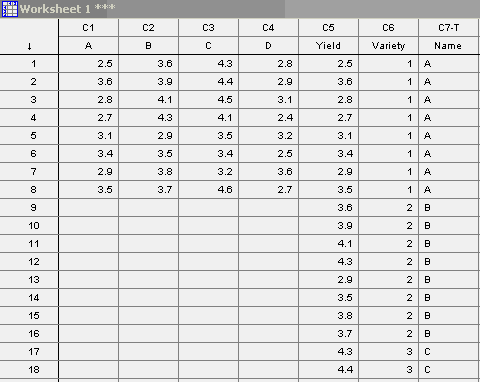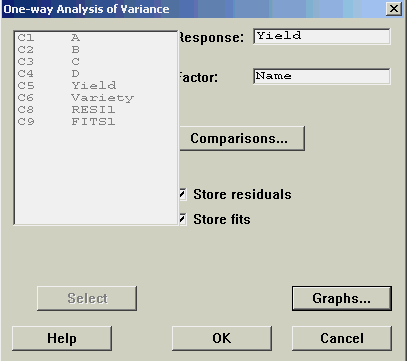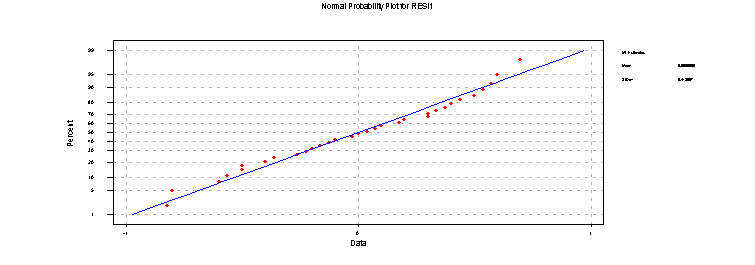We will use Minitab to solve this problem. The data should be stacked to run all of the above analyses. In addition we will use both numberic codes and alphabetic codes for the variaty names. Below is a partial printout of the worksheet (wouldn't all fit on the screen for a screen capture.)

The analysis of variance table for the one-way classification model is given below: (STAT>ANOVA> One Way)
One-way Analysis of Variance
Analysis of Variance for Yield
Source DF SS MS F P
Name 3 6.621 2.207 11.05 0.000
Error 28 5.594 0.200
Total 31 12.215
Individual 95% CIs For Mean
Based on Pooled StDev
Level N Mean StDev ---------+---------+---------+-------
A 8 3.0625 0.4033 (-----*------)
B 8 3.7250 0.4234 (------*-----)
C 8 4.0000 0.5503 (-----*-----)
D 8 2.9000 0.3928 (-----*-----)
---------+---------+---------+-------
Pooled StDev = 0.4470 3.00 3.50 4.00
With a p-value for the F-test below 0.00049 we would reject the null hypothesis of equal group means and consider the alternative that there are differences among the four varieties in average yield.
We begin by checking the assumption of homogeneity of variance. To do this we perform a test of variance with results given below: (STAT > ANOVA > Homogeniety of Variance).
Homogeneity of Variance Response Yield Factors Name ConfLvl 95.0000 Bonferroni confidence intervals for standard deviations Lower Sigma Upper N Factor Levels 0.240412 0.403334 1.03509 8 A 0.252385 0.423421 1.08664 8 B 0.328027 0.550325 1.41232 8 C 0.234128 0.392792 1.00804 8 D Bartlett's Test (normal distribution) Test Statistic: 1.031 P-Value : 0.794 Levene's Test (any continuous distribution) Test Statistic: 0.565 P-Value : 0.643
Both Bartlett's Test and Levene's Test suggest that there are NO significant differences among the variances of the four groups. Hence we DO NOT reject the null hypothesis of equal variances.
We reserve the decision on whether the data need to be transformed until we look at the question of normality of the residuals. In the dialog box associated with performing the ANOVA there are two checkboxes that give us the option to compute residuals and model fits (Fits is another word for the predicted mean).

These options add two columns to the worksheet, RESI1 and FITS1. Using GRAPH>PROBABILITY PLOT one can produce the normal probability plot to check on normality of the residuals.

I have used the edit capabilities of Minitab to highlight the points, color them and increase their size so you can see them. Note that there is some systematic deviation from linearity but not a whole lot. In this case this is probably not enough to force us to change our analysis or even enough to merit considering a transformation of the response.
Finally we perform the Kruskal Wallis procedure on the data (STAT > Nonparametrics > Kruskal-Wallis ).
Kruskal-Wallis Test Kruskal-Wallis Test on Yield Name N Median Ave Rank Z A 8 3.000 11.1 -1.89 B 8 3.750 21.9 1.87 C 8 4.200 24.4 2.74 D 8 2.850 8.7 -2.72 Overall 32 16.5 H = 16.50 DF = 3 P = 0.001 H = 16.56 DF = 3 P = 0.001 (adjusted for ties)
With such small p-values it is clear that we reject the null hypothesis of equal variety medians and conclude that the group differ in their true median values.